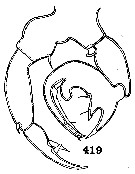|
|
 |
Fiche d'espèce de Copépode |
|
|
Calanoida ( Ordre ) |
|
|
|
Diaptomoidea ( Superfamille ) |
|
|
|
Pontellidae ( Famille ) |
|
|
|
Pontella ( Genre ) |
|
|
| |
Pontella meadi Wheeler, 1901 (F,M) | |
| | | | | | | Syn.: | Pontella pennata Wilson, 1932 (p.27, figs.F,M); 1932 a (p.150, figs.F,M); Wilson, 1942 a (p.203); Grice, 1956 (p.68); 1960 (p.220);
no Pontella meadi : Chiba, 1956 (p.52, figs.M, Rem.) | | | | Ref.: | | | Wheeler, 1901 (p.180, figs.F,M): Wilson, 1932 a (p.153, figs.F,M); 1950 (p.295, figs.F,M); Fleminger, 1957 (p.26: Rem.); Silas & Pillai, 1973 (1976) (p.776, 834); Chen & Marcus, 1997 (p.587, Rem: egg) |  issued from : C.B. Wilson in Bull. U.S. natn Mus., 1950, 100 (14) (4). [Plate 28, 417-418]. Female (from Gulf of Mexico): 417, habitus (dorsal); 418, P5. When alive or freshly preserved there is a row of dark blotches, one on each segment, along the dorsal midline of the metasome.
|
 issued from : C.B. Wilson in Bull. U.S. natn Mus., 1950, 100 (14) (4). [Plate 28, 419]. Male: 419, P5.
| | | | | Ref. compl.: | | | Wilson, 1932 (p.26); Dawson, 1966 (p.176); Sherman & Schaner, 1968 (p.583, fig.1); Grice & Gibson, 1977 (p.410, resting eggs); Turner, 1977 (p.249, fecal pellets); 1979 (p.131, fecal pellet/microbial); Turner & al., 1979 (p.289, Tab.3, fecal pellets); Grice & Marcus, 1981 (p.125, Dormant eggs, Rem.: p.134); Madhupratap & al., 1996 (p.77, Table 2: resting eggs); Marcus, 1996 (p.144); Suarez-Morales & Gasca, 1997 (p.1525); Mauchline, 1998 (tab.40, 47); Suarez-Morales & Gasca, 1998 a (p.110); Frangoulis & al., 2005 (p.254, Table I: C/N/P fecal pellet composition) | | | | NZ: | 2 | | |
|
Carte de distribution de Pontella meadi par zones géographiques
|
| | |  issued from : J.T. Turner in Mar. Biol., 1977, 40. [p.254, Fig.3]. Pontella meadi from estuarine waters near Galveston (Texas). issued from : J.T. Turner in Mar. Biol., 1977, 40. [p.254, Fig.3]. Pontella meadi from estuarine waters near Galveston (Texas).
3: Fecal pellet produced on Skeletonema costatum plus Nitzschia sp. diet; 4: high magnification of area in square in 3.
Nota: Sinking rates of fecal pellets produced by the species, grazing on 4 different phytoplankton diets, ranged from 15 to 153 m/day, with a mean of 66 m/day.
In 1979, Turner (1979, p.249) points to that pellets were colonized by rod-shaped bacteria that became attached to the outside of the peritrophic membrane and were not of intestinal origin. |
| | | | Loc: | | | Caribbean, Yucatan, Yucatan (Ascension Bay), G. of Mexico, Galveston Bay (Texas), Louisiana (off Grand Isle, Turkey Point), Florida, Chesapeake Bay, Woods Hole, Georges Bank | | | | N: | 16 | | | | Lg.: | | | (45) F: 2,65-2,35; M: 3-2,75; (45’) F: 3,25-3; M: 3,5-3; (632) F: 3,5-3; M: 3,25-2,85; {F: 2,35-3,50; M: 2,75-3,50} | | | | Rem.: | semble proche de Pontella lobiancoi
Voir aussi les remarques en anglais | | | Dernière mise à jour : 02/10/2020 | |
|
|
 Toute utilisation de ce site pour une publication sera mentionnée avec la référence suivante : Toute utilisation de ce site pour une publication sera mentionnée avec la référence suivante :
Razouls C., Desreumaux N., Kouwenberg J. et de Bovée F., 2005-2025. - Biodiversité des Copépodes planctoniques marins (morphologie, répartition géographique et données biologiques). Sorbonne Université, CNRS. Disponible sur http://copepodes.obs-banyuls.fr [Accédé le 24 décembre 2025] © copyright 2005-2025 Sorbonne Université, CNRS
|
|
 |
 |






